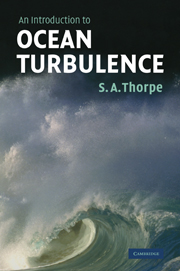Book contents
- Frontmatter
- Contents
- Preface
- Notes on the text
- Acknowledgements
- Abbreviations
- Standard parameters and symbols
- Units and their symbols
- SI prefixes
- Approximate values of commonly used measures
- 1 Turbulence, heat and waves
- 2 Measurement of ocean turbulence
- 3 Turbulence in oceanic boundary layers
- 4 Turbulence in the ocean pycnocline
- 5 Turbulent dispersion
- 6 The energetics of ocean mixing
- References
- Index
- Answers
6 - The energetics of ocean mixing
Published online by Cambridge University Press: 05 June 2012
- Frontmatter
- Contents
- Preface
- Notes on the text
- Acknowledgements
- Abbreviations
- Standard parameters and symbols
- Units and their symbols
- SI prefixes
- Approximate values of commonly used measures
- 1 Turbulence, heat and waves
- 2 Measurement of ocean turbulence
- 3 Turbulence in oceanic boundary layers
- 4 Turbulence in the ocean pycnocline
- 5 Turbulent dispersion
- 6 The energetics of ocean mixing
- References
- Index
- Answers
Summary
Introduction
The study of ocean turbulence may be viewed as a key component in the investigation of the ocean's processes and their energetics: how the energy supplied from external sources is distributed and eventually dissipated by the external and internal processes of mixing referred to in Section 3.1. The ocean is driven mainly by forcing from the atmosphere at the sea surface and by the tidal body forces imposed by the gravitational attraction of the Moon and the Sun. Relatively insignificant are the localized, but spectacular, inputs of energy from hydrothermal vents in the deep ocean ridges, the fortunately infrequent seismic movements of the seabed that may generate devastating tsunamis, the flux of geothermal heat through the floor of the abyssal plains and the energy inputs from rivers and the break-up or melting of ice sheets. The tidal forces and atmospheric inputs are the dominant sources of energy responsible for the overall circulation of the ocean (the kinetic energy of the mean flow) and its density structure (containing potential energy), and are the principal cause of the waves and the turbulence within the ocean.
The discussion in this chapter focuses on how turbulent mixing in the deep ocean is maintained. Much of the energy provided by the atmosphere is used in driving surface waves and the processes that sustain the structure of the upper ocean boundary layer.
- Type
- Chapter
- Information
- An Introduction to Ocean Turbulence , pp. 197 - 224Publisher: Cambridge University PressPrint publication year: 2007
- 1
- Cited by



